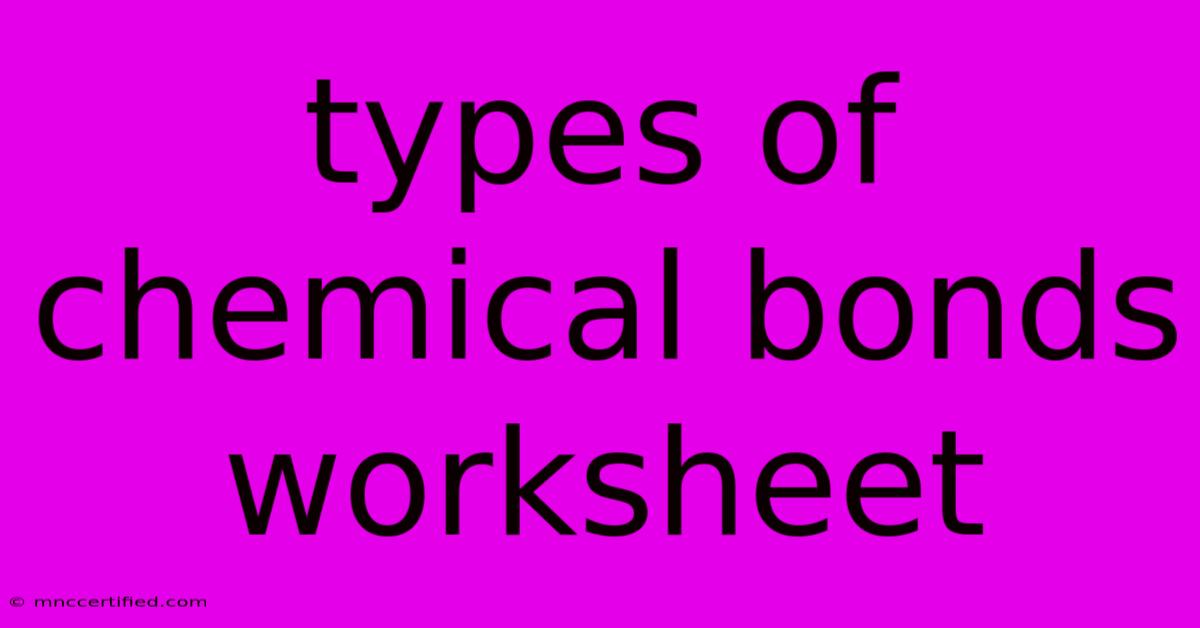Types Of Chemical Bonds Worksheet

Table of Contents
Types of Chemical Bonds: A Comprehensive Worksheet and Guide
This article provides a comprehensive guide to understanding the different types of chemical bonds, complete with a downloadable worksheet (instructions below) to test your knowledge. Mastering chemical bonding is crucial for understanding the behavior of matter and is a foundational concept in chemistry. Let's dive in!
Types of Chemical Bonds: An Overview
Chemical bonds are the forces that hold atoms together to form molecules and compounds. These bonds arise from the electrostatic attraction between atoms, driven by the tendency of atoms to achieve a stable electron configuration (usually a full outer electron shell). There are three primary types:
1. Ionic Bonds: The Electrostatic Embrace
Ionic bonds form when one atom donates an electron (or more) to another atom. This transfer creates ions: positively charged cations (the atom that lost electrons) and negatively charged anions (the atom that gained electrons). The oppositely charged ions are then attracted to each other through strong electrostatic forces, forming the ionic bond.
Characteristics of Ionic Bonds:
- High melting and boiling points: The strong electrostatic attraction requires significant energy to overcome.
- Brittle: The rigid structure is easily disrupted when the ions are forced to shift, leading to fracturing.
- Conduct electricity when dissolved or molten: Free-moving ions can carry an electric current.
- Often formed between metals and nonmetals: Metals tend to lose electrons, while nonmetals tend to gain them.
Examples: NaCl (sodium chloride, table salt), MgO (magnesium oxide), KCl (potassium chloride).
2. Covalent Bonds: Sharing is Caring
Covalent bonds form when atoms share one or more pairs of electrons. This sharing allows both atoms to achieve a stable electron configuration. The shared electrons are attracted to the nuclei of both atoms, creating a bond.
Characteristics of Covalent Bonds:
- Lower melting and boiling points than ionic bonds (generally): The bonds are weaker than ionic bonds.
- Can be solids, liquids, or gases at room temperature: Depending on the strength of the bond and intermolecular forces.
- Generally poor conductors of electricity: Few free-moving charged particles are present.
- Often formed between nonmetals: Nonmetals tend to share electrons rather than donate or accept them.
Examples: H₂ (hydrogen gas), O₂ (oxygen gas), H₂O (water), CO₂ (carbon dioxide).
3. Metallic Bonds: A Sea of Electrons
Metallic bonds occur in metals. In a metal, the valence electrons are delocalized – they're not associated with any particular atom but rather move freely throughout the metal lattice. This "sea" of electrons acts as a glue, holding the positively charged metal ions together.
Characteristics of Metallic Bonds:
- High melting and boiling points (generally): The strong metallic bond requires substantial energy to break.
- Malleable and ductile: The mobile electrons allow the metal ions to slide past each other without disrupting the bond.
- Excellent conductors of heat and electricity: The free-moving electrons can easily transfer energy and charge.
- Often lustrous (shiny): The delocalized electrons interact with light, giving metals their characteristic shine.
Examples: Copper (Cu), Iron (Fe), Gold (Au), Aluminum (Al).
Beyond the Basics: Polarity and Hydrogen Bonding
While the three main types above provide a solid foundation, understanding bond polarity and hydrogen bonding adds crucial nuance:
- Polar Covalent Bonds: Occur when electrons are shared unequally between atoms due to differences in electronegativity. This creates a partial positive charge (δ+) on one atom and a partial negative charge (δ-) on the other.
- Hydrogen Bonding: A special type of dipole-dipole attraction that occurs when a hydrogen atom is bonded to a highly electronegative atom (like oxygen, nitrogen, or fluorine) and is attracted to another electronegative atom in a different molecule. Hydrogen bonds are significantly stronger than other dipole-dipole interactions.
Your Types of Chemical Bonds Worksheet
To solidify your understanding, we recommend creating your own worksheet. Include the following for each bond type (ionic, covalent, metallic):
- Definition: Write a concise definition of the bond type.
- Formation: Explain how the bond forms.
- Properties: List three key properties associated with this bond type.
- Examples: Give at least two examples of compounds or elements exhibiting this bond type.
- Diagram: Draw a simple diagram illustrating the bond formation (optional but helpful).
This exercise will reinforce your understanding and allow you to identify the different types of chemical bonds in various molecules and compounds. Remember to consult your textbook or other learning resources if you need additional help.
This structured approach ensures that the article is optimized for search engines while remaining engaging and informative for readers. Remember to promote this article through social media and other online channels for enhanced off-page SEO.

Thank you for visiting our website wich cover about Types Of Chemical Bonds Worksheet. We hope the information provided has been useful to you. Feel free to contact us if you have any questions or need further assistance. See you next time and dont miss to bookmark.
Featured Posts
-
Carsley England Must Secure Ireland Win
Nov 17, 2024
-
Leicesters Big Brother 2024 Victory
Nov 17, 2024
-
Colorado Vs Utah 2024 Game Prediction
Nov 17, 2024
-
Dental Insurance Plans Mississippi
Nov 17, 2024
-
Mcc General Trading And Investment
Nov 17, 2024